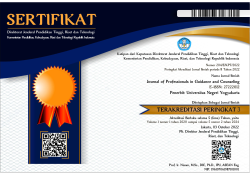The senior year students’ persistence profile of UMTAS (University of Muhammadiyah Tasikmalaya)
Feida Noor Laila Isti’adah, University of Muhammadiyah Tasikmalaya, Indonesia
Agung Nugraha, University of Muhammadiyah Tasikmalaya, Indonesia
Abstract
This study aims to determine the profile of senior year students at the end of class 2015 that have been studied for 4 years or undergraduate students (S1). This descriptive study was conducted to 10 study programs (S1) at the University of Muhammadiyah Tasikmalaya with a sample number of 142 students. Measuring instrument employed in the form of a questionnaire multiple choice that refers to the grand theory of Pury (Lopez, 2009), which was designed by the researcher in 2019. The results revealed that the persistence of 2015 students was in high category with a percentage of 77.33%. The number of final-level students in the high category of 85% or 121 students, in addition there were 14% or 20 students who belonged to the medium category and 1% or 1 student was in the low category. This indicates that in general, the senior students at the Universitas Muhammadiyah Tasikmalaya have demonstrated maximum persistence in each dimension, including having high desire and awareness to pursue their goals, doing hard effort sustainably, instilling persistent character in resolving the problems, as well as the students can survive and move forward despite the challenges and difficulties in achieving their objectives.
Keywords
Full Text:
PDFReferences
Brown, S. D., Tramayne, S., Hoxha, D., Telander, K., Fan, X., & Lent, R. W. (2008). ‘Social cognitive predictors of college students’ academic performance and persistence: A meta-analytic path analysis’. Journal of Vocational Behavior, 72, 298–308.
Hill, Napoleon. (2019). Think and grow rich. Jakarta : Bhuana Ilmu Populer.
Irawati. (2013). NN. Diakses pada tanggal 10 Mei 2019. Tersedia di : http://eprints.ums.ac.id/24521/2/04._BAB_I.pdf.
Isti’adah, Feida N.L.(2018). Komparasi self regulated learning pada mahasiswa yang bekerja dan tidak bekerja. Journal of InnovativeCounseling :Theory, Practice & Research, 3(1):pp.1-5.
Lopez, Shane J. (2009). The encyclopedia positive psychology. Blacwell Publishing Ltd. ISBN: 978-1-405-16125-1.
Mugiarso, Heru., et al. (2018). ‘Self-Efficacy dan Persistence Mahasiswa Ketika Mengerjakan Skripsi Ditinjau dari Kecemasan Akademik’. Jurnal Bimbingan dan Konseling, 1 (3), 171-175. Diakses pada tanggal 26 Oktober 2018 [online]. Tersedia di : https://www.researchgate.net/publication/323940700_Self-efficacy_dan_persistensi_mahasiswa_ketika_mengerjakan_skripsi_ditinjau_dari_kecemasan_akademik.
Palila, Sara. (2016). Analisis kebutuhan karakter mahasiswa psikologi fakultas ilmu sosial dan humaniora UIN Sunan Kalijaga Yogyakarta. Diakses pada tanggal 12 Januari 2019 [online]. Tersedia di : http://journal.uad.ac.id/index.php/HUMANITAS/article/view/3838.
Peterson, C., Seligman, M. E. P. (2004). Character strengths and virtues : A Hanbook and Classification. New York : Oxford University Press.
Vanthournout, gert et al, (2012). Students’ Persistence and Academic Success in a First-Year-Professional Bachelor Program: The Influence of Student’s Learning Strategies and Academic Motivation. Education Research International Volume 2012, Article ID 152747, 10 pages.
Wright, S. L., Jenkins-Guarnieri, M. A., & Murdock, J. L.. (2012). Career Development, 40(4), 292-310.
Zamista, Adelia Alfama. (2017). Increasing persistence of collage student in science technology engineering and mathematic (STEM). Journal of Teachimh and Learning Vol 3 No 1 2018.
DOI: https://doi.org/10.21831/progcouns.v1i2.34649
Refbacks
- There are currently no refbacks.

This work is licensed under a Creative Commons Attribution-ShareAlike 4.0 International License.
Supervised by:

Our journal indexed by:
ISSN 2722-6581 (print) || ISSN 2722-2012 (online)
ProgCouns Stats









